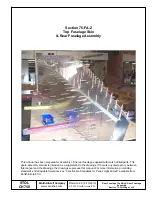
© 2008 Stevens AeroModel.
Page 10 of 52
Fuselage
General Construction Notes: This fuselage utilizes an improved tab and notch construction method developed by Stevens
AeroModel. Each component precisely interlocks using unique tab and notch sizes to allow the parts to only fit in one
direction. Where parts orientation can be reversed or inverted parts are scribed with a reference such as “top” or “front”
for proper orientation. Throughout construction we suggest dry-fitting all components, and using minimal amounts of glue
at tab and notch locations only to hold parts together. By dry fitting the fuselage, each successive component will assist
with pulling the assembly square and straight.
1.
Begin construction of the fuselage by completing the following sub assemblies: Build 3/32 in. balsa former F12
from parts F12a, F12b, and F12c (sheets 14 and 16/21). Build 1/16 in. balsa former F15 from parts F15a and
F15b (sheet 12/21). Build two each 3/32 in. balsa fuselage sides FS from parts FSa, FSb, and corresponding
truss parts (sheets 14, 15, and 16/21) when constructing fuselage sides use a straight edge to align part along
bottom edge, see illustration below the following diagram. Build 3/32 in. balsa former F11 from parts F11a and
F11b (sheet 13/21). Finally, build 3/32 in. balsa hatch component H1 from parts H1a, H1b, and H1c (sheet
13/21).
A
A
B
B
A
B
FSa
FSb
H1
b
H1
a
H1
c
F12a
F12c
F12b
F15a
F
15b
F11a
F11b
F12
F15
F11
H1
FS
2.
Reference plan set for location of provided 4-40 blind nuts based on selected motor type then install to back
side of 1/8 in. lite plywood former F1 (sheet 21/21). The second photo in this series shows the F1 firewall with
blind nuts installed as viewed from the front. Secure blind nuts with gap filling medium CA glue. Set F1 aside.











































